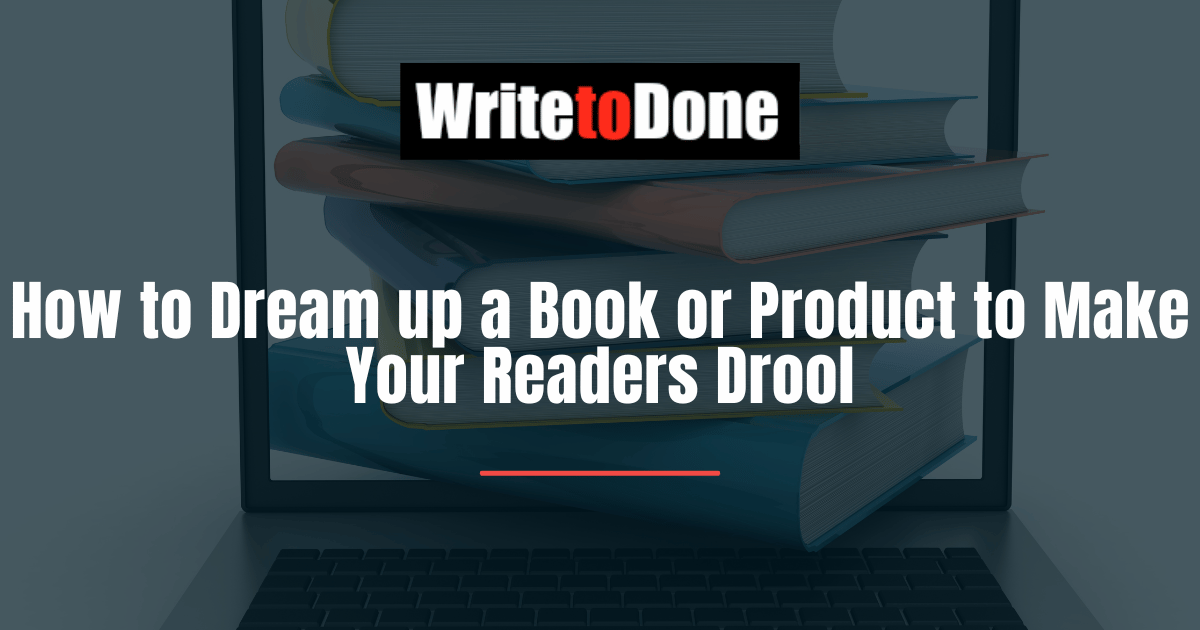Have you thought of creating a product or a book?
I bet it’s crossed your mind.
But what kind of product could you create?
What would your readers like?
What would they buy?
You’re puzzled and don’t know how to proceed, right?
And even if you do come up with a possible product, you’re still baffled, because you can’t work out whether it’s a good idea or not.
Does this scenario seem familiar?
I know all about these doubts and worries because I’ve created many different products.
Creating a product takes a lot of time, and if you’re simply guessing whether it will be successful or not, you can end up with a blob of nothing languishing on your hard-drive.
I’ve seen it happen: writers create reports, ebooks, apps, courses or other products.
Then they wait for the big moment when it all pays off.
They watch for their subscriber count to skyrocket and their sales stats to go into orbit.
But what happens?
Nothing. Because they’ve created a product that wasn’t viable.
Luckily, there is a way to quickly evaluate your ideas before starting to work on a product.
Can you imagine what a shortcut this would be to your success?
You see, creating a product doesn’t guarantee success—especially if you make a key mistake.
The dumb mistake people make with their first product
The mistake that most people make is that they put too much effort into creating a product.
Huh?
Sounds crazy, doesn’t it? But hear me out.
Here’s what happened recently with a student of mine (let’s call her Eva) who runs a blog about travel photography.
We were talking on Skype. Eva was excited and told me that she’d started to write an ebook to earn some money.
‘I just have to write it,’ she said, ‘I’ve always wanted to write about how listening to your own inner guide can make us better people.’
I started to get a bad feeling about this…
‘Hmmm… did you do any research on whether this topic is right for your readers?’
‘Research?’
‘Yes, research. Did you ask your readers whether they would actually buy the book?’
‘Oh! Well, no, I didn’t.’
I’m sure you can spot Eva’s mistake.
She followed her passion—without checking out whether the ebook would be a good fit for her audience.
Don’t get me wrong—passion is important. But you want to sell your product, right?
We’re going to look at a two-step process: coming up with ideas and then evaluating them. In particular, I want to introduce you to a simple but powerful way to evaluate your product idea in ten seconds flat.
Your first step is to brainstorm ideas.
How to generate creative ideas
Brainstorming is a great way to generate ideas.
Watch the short video below which presents six creative ways to brainstorm ideas:
Once you’ve got a list of product ideas, it’s time to evaluate them.
Because before you embark on creating a product, you need to evaluate whether your ideas are viable.
The test can be done in ten seconds.
Is your product Oxygen, Aspirin, or Jewelry?
This question can determine—in ten seconds—whether your product idea was born to soar, or to plummet.
Janet J. Kraus originally created the question ‘Is it Oxygen, Aspirin or Jewelry?’ as a quick framework to test the vitality of a startup idea.
It works for products as well. Isn’t that cool?
Oxygen is something that is necessary for survival, Aspirin is something that eases the pain, and Jewelry indicates something that is a luxury.
Why ‘desperate’ is a marker for Oxygen products
Oxygen products are necessary for survival. If we dial that down a bit, it can refer to products that fulfill the need for an instant solution.
For example, if you’re an insomniac, you’re in urgent need of sleep strategies. If you have a chronic health condition, you’re desperate to find a cure; if you’ve lost your job, you need to find another source of income quickly. And if you’re lonely, you can be desperate to find a mate.
These are all examples of a need for Oxygen products to solve the problem instantly.
In fact, the word ‘desperate’ can immediately alert you to a potential Oxygen product.
Let’s take a look at two examples of Oxygen products.
Imagine that you’re an insomniac. You’ve tried everything! Wary of getting hooked on sleeping pills, and desperately tired, you search for ways to get some sleep.
These are the people Dr. Caroline Wheeler targets with her SleepKit.
Dr. Wheeler is a medical doctor with an NLP background and has come up with a perfect solution for insomniacs. Her SleepKit reshapes people’s sleep response with the help of podcasts, videos, and guided relaxation exercises.
It’s a perfect Oxygen product!
The second example is a product created by Tracy Raftl at TheLoveVitamin.
For years, Tracy suffered from severe acne.
Tracy says of her own experience:
“People who have never had acne don’t quite understand how painful this condition is—both physically and emotionally… I felt so incredibly desperate and anxious beyond anything I had ever felt before.”
She started a blog to document her story of overcoming acne and then created a program—the Naturally Clear Skin Academy which helps sufferers clear their skin of acne the natural way.
Again, this is a great Oxygen product!
Can you think of something in your niche where people are desperate for a solution?
If you can find an Oxygen product, you are set for success. But if you can’t find an Oxygen product, you may be able to find an Aspirin product.
How Aspirin products ease the pain
When you study comments on your blog, check out social media, or read emails from your readers, you’ll see that many of your readers talk about the same pain points.
Aspirin products are created to ease the pain.
A good example of an Aspirin product is Learn Scrivener Fast.
As you may know, Scrivener is a program that makes writing easier. It works for blog posts, as well as for big projects like ebooks or novels.
Learn Scrivener Fast is a course that shows how to use Scrivener. It’s a useful product because Scrivener has a lot of different options and can seem overwhelming.
This is a good example of an Aspirin product because it eases the pain of writing.
What about your niche? Are there tools you find useful?
Think about creating a training program that shows others how to use your favorite tool.
If you can create a product that give solutions to ease your readers’ pain or frustration, you’re on to a winner.
But your audience might love another kind of product. A product that can make life more enjoyable.
Why Jewelry products are dreams come true
Jewelry refers to products that are a luxury, not a necessity.
Think about it. What do your readers dream of?
What would enhance their lives?
Let’s take a look at two examples of Jewelry products.
Sisters Laura Forbes Carlin and Alison Forbes run Inspired Everyday Living, a blog about creating an inspiring home environment.
They created the course Five Practices to Change Your Home and Life, which shows how simple changes to your home can enhance your life.
In this course, Laura and Alison show how to use the home as a powerful vehicle for change, to increase happiness and boost your romantic life.
Their course is really a Jewelry as well as an Aspirin product because it helps people create an inspiring home environment and makes them feel happier.
The second example of a Jewelry product is a video game called Just Dance.
This video game shows you dance moves to 40 top tracks. It’s interactive, so you can even become part of the game by recording your own moves and becoming a Just Dance coach for your favorite track.
This product is pure entertainment and a perfect example of a Jewelry product.
What about Jewelry products for your niche?
Can you think of gadgets, apps, courses or software programs in your niche that would be useful, entertaining, or beautiful?
Do you have an interesting idea that would enhance the way people live?
These questions will lead you to products that inspire, give pleasure, or entertain.
What if you dream up a product which covers all three aspects—Oxygen, Aspirin, and Jewelry?
The best product ideas, Janet Kraus believes, should have aspects of all three.
If that’s the case, you won’t have trouble selling your product!
Just think of mobile phones. As Ilan Mochari points out, it is simultaneously Oxygen ( using phone or email), Aspirin (using apps with which you can communicate or pay for things), and Jewelry (enjoying games, music).
A Quick Way to Rank Your Ideas
Here’s how to use the Oxygen, Aspirin, Jewelry yardstick on the list of product ideas you brainstormed:
- Go through your list and tag each idea with the letters O, A or J, depending on whether they fit the criteria for Oxygen, Aspirin, or Jewelry.
- Cross out ideas that don’t have any tags.
- Now create a new list, starting with product ideas which include the Oxygen tag. This is important because Oxygen products sell most easily.
- Next, add the ideas that have the Aspirin tag. These products can also sell pretty well.
- Further down, list the product ideas with the Jewelry tag. Depending on your niche, you’ll want to screen these product ideas very carefully, as Jewelry products are more difficult to sell.
- Once you’ve completed this exercise, bold the product ideas that have more than one tag, especially if they include the Oxygen tag.
These are your most viable ideas.
The next phase in developing your product is to test your viable ideas. There are many ways to test your ideas.
I’ll write more about how to test your ideas in a future post, but for now, consider writing about your ideas and checking the comments on your blog or in social media for positive responses.
Of course, you don’t want to give away your exact product idea, but you can write about the pain points and ask how important it would be to find a solution.
The value of Janet J. Kraus’ framework
If you want to create a product, whether it’s a book or a digital product, it’s important to be economical with your time and energy.
What you need to avoid is having an idea and then fixating on it. I’ve seen people spend days and weeks outlining and planning courses that are barely viable because they forgot to evaluate their ideas before moving into the planning phase of development.
If you could evaluate your ideas before starting to create a product, wouldn’t that make your life a lot easier?
The first step of brainstorming should be free of any constraints. You need to include even weird ideas, as you shouldn’t pre-judge ideas in the brainstorming phase.
Once you’ve got your list of ideas, using the Oxygen, Aspirin, Jewelry framework is a great way to weed out ideas that won’t get you anywhere. It will allow you to identify viable product ideas.
I’ve certainly found the Oxygen, Aspirin, Jewelry framework very helpful in my own work.
Please let me know your thoughts in the comments.
And, if you enjoyed this post, please do share it on social media. 🙂




















